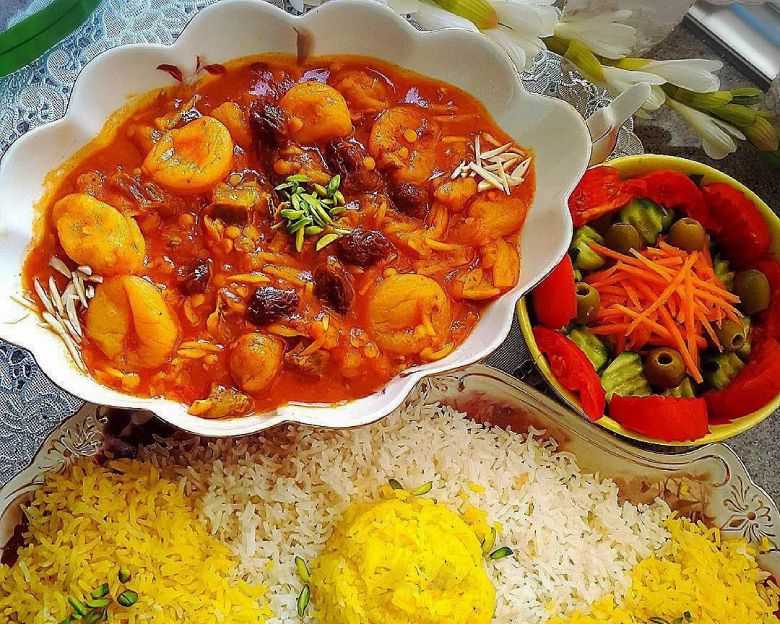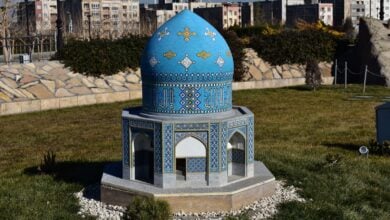
Hamedan Travel Guide offers a glimpse into the rich history and diverse attractions of one of Iran’s oldest cities.
Hamadan, one of the western provinces of Iran, boasts a rich history. It is known as the capital of Iranian civilization. Particularly popular during the Nowruz holidays and the first half of the year, Hamadan attracts numerous domestic tourists.
Hamadan Province is bordered by Zanjan and Qazvin provinces to the north, Markazi Province to the east, and Kurdistan and Kermanshah provinces to the west. The unique historical and natural attractions, warm hospitality, and charming souvenirs of Hamadan make it a favorite destination for summer and Nowruz vacations. By reading this travel guide by OrientTrips, you can gather all the necessary information for your trip to Hamadan.
Contents
Hamedan Travel Guide: Essential Tips for Visitors

Hamadan has been a settlement for Iranian tribes for thousands of years due to its geographical location and climate. Excavations at Tepe Giyan in Nahavand date back at least 6,000 years and the Kassites lived in this region long ago. Based on archaeological findings, the history of civilization in Hamadan Province dates back to at least the third millennium BCE. Hamadan is often associated with the Median Empire. In the late 8th century BCE, the Medes, led by Deioces, the first king of the Medes, rose to power and chose Hamadan as their capital, known as Ecbatana. Today, remnants of Deioces’ city and fortress can still be seen on the Ecbatana Hill.
During the Achaemenid Empire, Hamadan flourished as the summer capital of the Achaemenid kings. Remains from this period highlight the region’s significance.
Hamadan suffered greatly during Alexander the Great’s invasion of Iran, with many villages being destroyed. However, the city maintained its importance during the Parthian and Sassanian periods. Throughout the Islamic era, Hamadan’s history has been marked by numerous conflicts and uprisings.
Hamadan does not have heavy traffic like Tehran and does not implement odd-even traffic regulations. The city’s streets are uniquely designed in a circular layout converging toward the city center, reminiscent of the ancient design of Hamadan (Ecbatana), which was constructed with seven concentric fortresses.
Hamadan, being in a mountainous region, experiences cold, windy winters and mild, pleasant summers. Temperatures can reach up to 36 degrees Celsius. The best time to visit Hamadan is during spring and summer, particularly from mid-May to late September.
Tourist Attractions in Hamadan

Hamadan’s natural and historical attractions are so captivating that visitors lose track of time. Ali Sadr Cave is one of the most famous attractions.
Notable attractions in Ganjnameh include the Ganjnameh Inscriptions, Ganjnameh Waterfall, and the Ganjnameh Cable Car. The village also offers numerous recreational facilities, such as cafes, restaurants, restrooms, a ski slope, a bowling alley, a bungee jumping platform, a zip line, a trial track, rock climbing, an aerial balance course, and a toboggan run.
Following Ali Sadr Cave is the Ganjnameh Tourist Village, located 5 kilometers west of Hamadan. It houses several tourist attractions. The pleasant mountainous climate in the Elvend Valley and the stunning view of the Mishan Plain draw both domestic and international tourists. Even in spring, visitors can find snowy mountains in the Ganjnameh Tourist Village. Tourists enjoy snow activities, skiing, local dishes like Ash-e Doogh, and the refreshing Ganjnameh Waterfall.

Other natural and historical attractions in Hamadan include the Ekbatana Dam Lake (11 kilometers east of Hamadan). It has green spaces and recreational facilities like restaurants, inns, boating, and water skiing. Giyan Spring, located 30 kilometers south of Nahavand, is another beautiful natural attraction. It is surrounded by ancient plane trees and archaeological sites dating back thousands of years. “Giyan” means “life” in Kurdish, and the area’s beauty has earned it the name Giyan Spring. Visitors can set up tents and relax on the cement platforms above the spring.
Visiting the famous and valuable tombs in Hamadan is a must. Among Hamadan’s most significant attractions are Baba Tahir’s Tomb, the mausoleum of the Persian poet and mystic of the late 10th and early 11th centuries, and Avicenna’s Tomb, the mausoleum of the renowned Persian physician, philosopher, and poet.

Traveling to Hamadan is possible via airplane, intercity buses, train, and private car. Each mode offers unique experiences and convenience.
How to Travel to Hamadan
IRAN GROUP TOURS
Join our Iran tours, connecting you with like-minded travelers and streamlining the organization process.
Airlines like Aseman, Iran Air, and Mahan operate flights to and from Hamadan, covering routes including Shiraz, Tabriz, Tehran, Ahvaz, and Bandar Abbas.
The largest terminal, located at Ashura Square, offers services to all parts of the country. The Ekbatana Terminal, located on Ekbatana Street, serves intercity routes. The Sefid Ab Terminal, located on Badi’ al-Zaman Hamadani Boulevard, serves local routes.
Traveling to Hamadan is possible via airplane, intercity buses, train, and private car.
Airplane: Many travelers prefer the convenience and time-saving aspect of flying. Hamadan Airport, located 5 kilometers from the city, operates at least two flights daily between Tehran and Hamadan.
Bus: One of the most common ways to travel is by bus. Hamadan has three main bus terminals.
- The largest terminal, located at Ashura Square, offers services to all parts of the country.
- The Ekbatana Terminal, located on Ekbatana Street, serves intercity routes.
- The Sefid Ab Terminal, located on Badi’ al-Zaman Hamadani Boulevard, serves local routes.
Train: Travelers who prefer trains disembark at Malayer Railway Station, the only railway station in Hamadan Province. Trains run every two days between Tehran and Malayer.

These roads include the Saveh-Hamadan and Zanjan-Hamadan routes, which are commonly used by travelers.
Private Car: Travelers driving from Tehran to Hamadan should take the Tehran-Saveh and Saveh-Hamadan roads. Other routes include Qazvin-Hamadan and Buin Zahra-Hamadan. The busiest routes into Hamadan Province are the northern entry roads.
Public Transportation in Hamadan

Hamadan does not have heavy traffic like Tehran and does not implement odd-even traffic regulations. The city’s streets are uniquely designed in a circular layout converging toward the city center, reminiscent of the ancient design of Hamadan (Ecbatana), which was constructed with seven concentric fortresses. Public transportation options include buses and taxis, but there is no metro system.
If you lack internet access, you can call Hamadan’s radio taxis at 1844, 1833, 1828, and 1820 (for women).
Buses: Hamadan’s bus system uses an electronic ticket system with 200 buses operating within the city. On average, buses transport about 1,000 passengers daily, with a waiting time of approximately 20 minutes.
Taxis: Taxis, both route-based and round-trip, are available throughout Hamadan for intra-city travel. Taxi fares in Hamadan are relatively reasonable compared to larger cities in Iran. Smart internet taxis are also popular.
Hotels and Accommodations in Hamadan
BOOK ONLINE
Iran Hotels
In Hamadan, you can find suitable and reasonably priced hotels and accommodations. Various options include hotels, inns, and private lodgings ready to welcome visitors.
Luxury Hotels in Hamadan: Notable luxury hotels include the 4-star Bu Ali Hotel, International Amiran Hotel, and Parsian Hotel.
Mid-range Hotels in Hamadan: Three-star hotels include Khate-e Motel Hotel Apartment, Varzesh Hotel Guesthouse, and Arian Hotel.
Budget Hotels in Hamadan: Affordable options include the 2-star Jahangardi Alisadr Cave Hotel, Workaneh Eco-lodge, and Amadai Eco-lodge.
Restaurants and Fast Food in Hamadan
When you visit Hamadan, besides enjoying the beautiful attractions, you can savor delicious Iranian, local, and international cuisines.
When you visit Hamadan, besides enjoying the beautiful attractions, you can savor delicious Iranian, local, and even international cuisines. The city has several restaurants where you can rest, satisfy your hunger, and enjoy tasty dishes. For authentic traditional food, visit Aryayian Restaurant or Dizi Saray Aryayian and enjoy a hearty meal with local yogurt.
For a taste of exquisite Iranian cuisine, try Dariush Restaurant in the Ganjnameh area. It offers a serene atmosphere and high-quality food.
If you crave Italian food, Delzhin Italian Restaurant located near Bu Ali Hotel serves various delicious Italian pizzas and pastas.
Local Foods of Hamadan

While discussing food, it’s worth mentioning the local delicacies of Hamadan. Make sure to try at least one of these during your visit. Famous local dishes include Hamadan Gheymeh Stew, Rice Soup, Amaj Soup, Eggplant Soup, Kachi Soup, Dried Fruit Soup, Sardashi Kebab, and Pepper Stew.
Shopping and Markets in Hamadan

Shopping is always a fun part of any trip. In Hamadan, you can explore various markets and shopping centers. Popular markets include the Grand Bazaar of Hamadan, Zagros Tower, Mahestan Shopping Center, Ghaem Mall, Pastor Tower, Kafashkhaneh Bazaar, Shahrara Shopping Center, and Khajeh Rashid Mall.
Note down these names and enjoy their delightful flavors in Hamadan.
Souvenirs of Hamadan

Hamadan offers both delicious treats and valuable handicrafts as souvenirs. Make sure to buy something as a token of your trip for your loved ones. Edible souvenirs include honey, Komaj, Bastegh, Chai bread, Angoshtpich, Gheichi candy, Raahat ol-Halqum, Beresaq, and Halva Loz.
Traditional Ceremonies in Hamadan
In Hamadan, traditional and important occasions are celebrated uniquely. Notable ceremonies include Nowruz, Kuseh and Zan Kuseh, Chaharshanbe Suri, and Sizdah Bedar.
Handicrafts you can take home include pottery, kilim rugs, leather goods, carpets, wooden frames, Giveh shoes, and engraved stones.
General Information about Hamadan
Religious ceremonies like mourning rituals in Muharram and Ramadan and Arafa Day ceremonies are also significant. Wedding traditions include proposal, engagement, bridal procession, henna night, bridal dress, wedding feast, bride’s turnover, bridal turn, and baby’s week.
Other significant occasions include the New Year celebration, Yalda Night (Chilla), Saman Puzan, Chahre Gerdan, and traditional rain prayers such as Chamcheh Khatoon, Hashli, and Cow-bar.
- Hamadan Code: 81
- Flight Duration from Tehran: Approximately 1 hour and 40 minutes
- Train Travel Time from Tehran: Approximately 2 hours (Rail distance from Tehran to Hamadan: 264 km)
- Bus Travel Time from Tehran: Approximately 4 hours (Road distance from Tehran to Hamadan: 320 km)
Hospitals and Medical Centers in Hamadan
If you are planning to travel to Hamadan, ensure you carry your health and medical insurance. Some hospitals and medical centers in Hamadan include:
- Bu Ali Hospital
- Address: Hamadan, Mahdieh Street, after People Park
- Phone: 8138381022
- Ekbatana Hospital
- Address: Hamadan, Taleghani Street
- Phone: 8138256120
- Shaheed Motahari Hospital
- Address: Hamadan, Shahid Khorram Roudi Boulevard
- Phone: 8138224003









